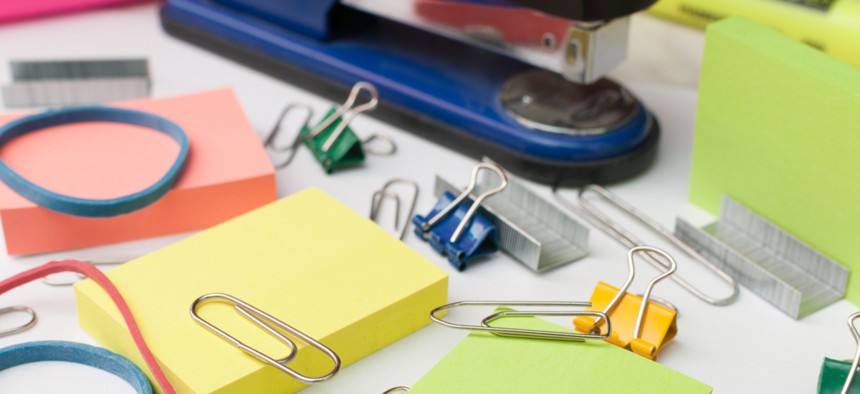Workplace Theft Is on the Rise

Shutterstock

Connecting state and local government leaders
As the line between work and home blurs, office supplies attract sticky fingers.
Your office is a den of thieves. Don’t take my word for it: When a forensic-accounting firm surveyed workers in 2013, 52 percent admitted to stealing company property. And the thievery is getting worse. The Association of Certified Fraud Examiners reports that theft of “non-cash” property—ranging from a single pencil in the supply closet to a pallet of them on the company loading dock—jumped from 10.6 percent of corporate-theft losses in 2002 to 21 percent in 2018. Managers routinely order up to 20 percent more product than is necessary, just to account for sticky-fingered employees.
Some items—scissors, notebooks, staplers—are pilfered perennially; others vanish on a seasonal basis: The burn rate on tape spikes when holiday gifts need wrapping, and parents ransack the supply closet in August, to avoid the back-to-school rush at Target. After a new Apple gadget is released, some workers report that their company-issued iPhone is broken—knowing that IT will furnish a replacement, no questions asked.
What’s behind this 9-to-5 crime wave? Mark R. Doyle, the president of the loss-prevention consultancy Jack L. Hayes International, points to a decrease in supervision, the ease of reselling purloined products online, and what he alleges is “a general decline in employee honesty.” The changing nature of the workplace may also bear some blame. Full-time employees now spend an average of 3.3 hours a day working from home—a fact reflected in the frequent disappearance of household items from the office. On social media, for instance, anonymous workers have confessed to stealing everything from light bulbs and toilet paper to Oreos, Windex smuggled out in a water bottle, and a fake Christmas tree. After one Reddit user expressed guilt over snatching coffee for weekend enjoyment, another poster offered a compelling rationalization: “You weren’t stealing the coffee. You were planning to work from home this weekend. Obviously you need coffee if you’re going to be working.” With the divide between apartment and cubicle blurring, taking stuff home isn’t even thought of as theft anymore, says Brian Friedman, the asset-protection director for HD Supply. “It’s [considered] an entitlement.”
You might not worry about sneaking off with the occasional package of Oreos. But David Welsh, a business professor at Arizona State University, says that even the pettiest of thefts can start workers down a crooked path. In a 2014 paper, Welsh and his co-authors concluded that peccadilloes such as taking a pen from the office tend to “snowball into larger violations” through a social-cognitive mechanism known as moral disengagement. The process is simple: Just create an internal monologue to minimize your unethical deed (It’s okay to steal this paper, because I print so many work documents at home). From there, your heists can escalate, while your self-image remains intact.
Don’t believe it? Then let me tell you about Gilberto Escamilla, the employee who stole $1.3 million worth of fajita meat from a juvenile-detention center in Texas. Escamilla, a correctional officer, pleaded guilty to felony theft for the scheme, which lasted nine years and included untold sums of brisket, pork chops, chicken, and sausage. At a 2018 hearing, Escamilla explained what had happened. “It started small and got bigger,” he said. “It got to a point where I couldn’t control it anymore.” The judge, unmoved, sentenced him to 50 years in prison.
Rene Chun is a contributing editor at Wired. This article was originally published in The Atlantic.

NEXT STORY: If You Really Want an Open Dialog, Then Act Like It




